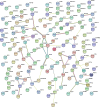Meta-analyses of genome wide association studies in lines of laying hens divergently selected for feather pecking using imputed sequence level genotypes
- PMID: 33004014
- PMCID: PMC7528462
- DOI: 10.1186/s12863-020-00920-9
Meta-analyses of genome wide association studies in lines of laying hens divergently selected for feather pecking using imputed sequence level genotypes
Abstract
Background: Feather pecking (FP) is damaging behavior in laying hens leading to global economic losses in the layer industry and massive impairments of animal welfare. The objective of the study was to discover genetic variants and affected genes that lead to FP behavior. To achieve that we imputed low-density genotypes from two different populations of layers divergently selected for FP to sequence level by performing whole genome sequencing on founder and half-sib individuals. In order to decipher the genetic structure of FP, genome wide association studies and meta-analyses of two resource populations were carried out by focusing on the traits 'feather pecks delivered' (FPD) and the 'posterior probability of a hen to belong to the extreme feather pecking subgroup' (pEFP).
Results: In this meta-analysis, we discovered numerous genes that are affected by polymorphisms significantly associated with the trait FPD. Among them SPATS2L, ZEB2, KCHN8, and MRPL13 which have been previously connected to psychiatric disorders with the latter two being responsive to nicotine treatment. Gene set enrichment analysis revealed that phosphatidylinositol signaling is affected by genes identified in the GWAS and that the Golgi apparatus as well as brain structure may be involved in the development of a FP phenotype. Further, we were able to validate a previously discovered QTL for the trait pEFP on GGA1, which contains variants affecting NIPA1, KIAA1211L, AFF3, and TSGA10.
Conclusions: We provide evidence for the involvement of numerous genes in the propensity to exhibit FP behavior that could aid in the selection against this unwanted trait. Furthermore, we identified variants that are involved in phosphatidylinositol signaling, Golgi metabolism and cell structure and therefore propose changes in brain structure to be an influential factor in FP, as already described in human neuropsychiatric disorders.
Keywords: Chicken; Feather pecking; Genome wide association study; Imputation; Meta-analysis; Whole genome sequencing.
Conflict of interest statement
Jens Tetens is associate Editor of BMC Genetics.
Figures




Similar articles
-
A genome-wide association study in a large F2-cross of laying hens reveals novel genomic regions associated with feather pecking and aggressive pecking behavior.Genet Sel Evol. 2017 Feb 3;49(1):18. doi: 10.1186/s12711-017-0287-4. Genet Sel Evol. 2017. PMID: 28158968 Free PMC article.
-
Genomewide Mapping of Selection Signatures and Genes for Extreme Feather Pecking in Two Divergently Selected Laying Hen Lines.Animals (Basel). 2020 Feb 6;10(2):262. doi: 10.3390/ani10020262. Animals (Basel). 2020. PMID: 32041297 Free PMC article.
-
A Novel Model to Explain Extreme Feather Pecking Behavior in Laying Hens.Behav Genet. 2020 Jan;50(1):41-50. doi: 10.1007/s10519-019-09971-w. Epub 2019 Sep 20. Behav Genet. 2020. PMID: 31541310
-
A meta-analysis on the effect of environmental enrichment on feather pecking and feather damage in laying hens.Poult Sci. 2021 Feb;100(2):397-411. doi: 10.1016/j.psj.2020.11.006. Epub 2020 Nov 19. Poult Sci. 2021. PMID: 33518091 Free PMC article.
-
Where in the serotonergic system does it go wrong? Unravelling the route by which the serotonergic system affects feather pecking in chickens.Neurosci Biobehav Rev. 2018 Dec;95:170-188. doi: 10.1016/j.neubiorev.2018.07.007. Epub 2018 Jul 25. Neurosci Biobehav Rev. 2018. PMID: 30055196 Review.
Cited by
-
Structural variation and eQTL analysis in two experimental populations of chickens divergently selected for feather-pecking behavior.Neurogenetics. 2023 Jan;24(1):29-41. doi: 10.1007/s10048-022-00705-5. Epub 2022 Nov 30. Neurogenetics. 2023. PMID: 36449109 Free PMC article.
-
The Impact of Probiotic Bacillus subtilis on Injurious Behavior in Laying Hens.Animals (Basel). 2022 Mar 30;12(7):870. doi: 10.3390/ani12070870. Animals (Basel). 2022. PMID: 35405859 Free PMC article. Review.
-
The Impact of Early-Life Cecal Microbiota Transplantation on Social Stress and Injurious Behaviors in Egg-Laying Chickens.Microorganisms. 2024 Feb 26;12(3):471. doi: 10.3390/microorganisms12030471. Microorganisms. 2024. PMID: 38543522 Free PMC article. Review.
-
The Relationships between Damaging Behaviours and Health in Laying Hens.Animals (Basel). 2022 Apr 11;12(8):986. doi: 10.3390/ani12080986. Animals (Basel). 2022. PMID: 35454233 Free PMC article. Review.
-
Comparison of genomic prediction accuracy using different models for egg production traits in Taiwan country chicken.Poult Sci. 2024 Oct;103(10):104063. doi: 10.1016/j.psj.2024.104063. Epub 2024 Jul 6. Poult Sci. 2024. PMID: 39098301 Free PMC article.
References
Publication types
MeSH terms
Grants and funding
LinkOut - more resources
Full Text Sources
Research Materials

